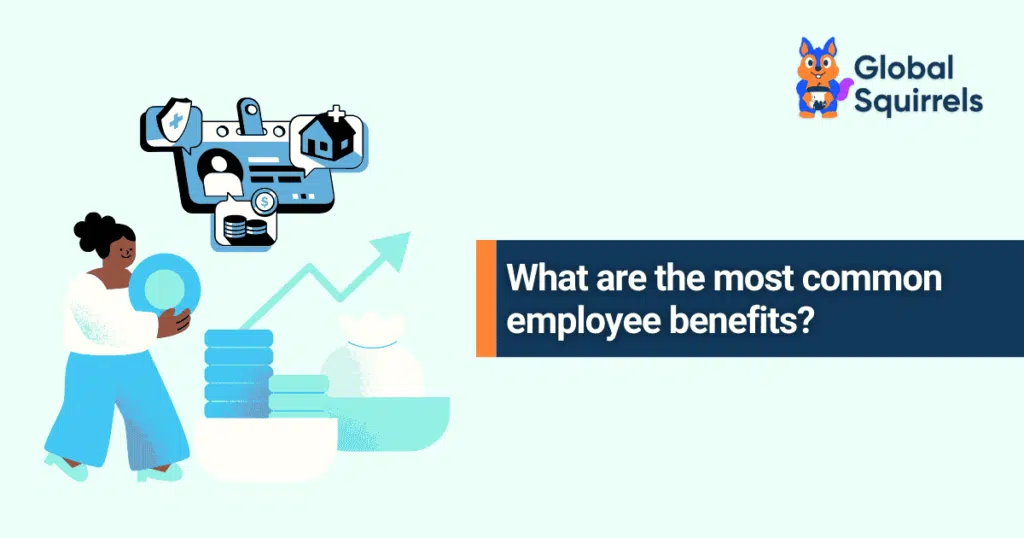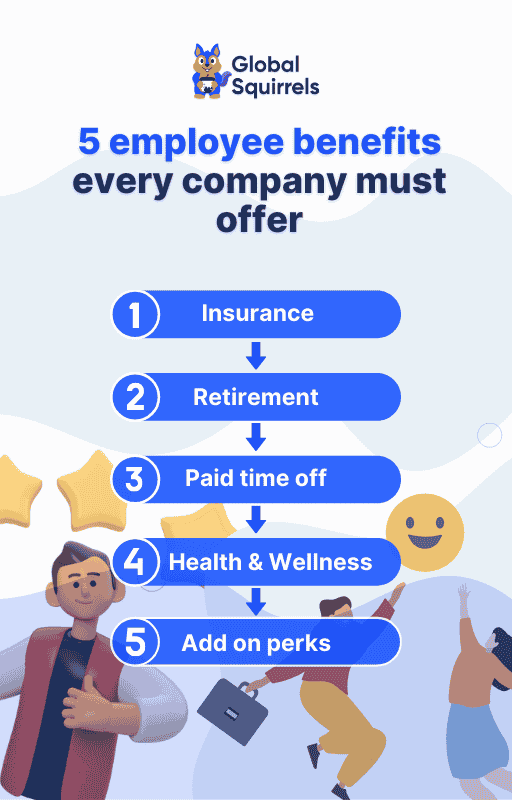What are the most common employee benefits?

The contemporary job market has become so competitive that retaining employees is a vital organizational objective. Although their salary remains a significant factor, employee benefits play a pivotal role in engaging and keeping a skilled workforce.
In this blog, we will discuss specific advantages and importance of these benefits. We will also explore common employee benefits, exploring their significance in creating a thriving workplace and highlighting the typical company benefits employees value most.
Understanding the right mix of common employee benefits can help you maintain a satisfied and motivated workforce. By tailoring benefit programs to meet both local regulations and employee needs, companies can build a stronger, more loyal workforce.
What are employee benefits and why are they important?
Employee benefits are compensations you provide that range from health-related perks to bonuses that have become essential in the current job market to attract and retain top talent. According to the Society for Human Resource Management’s (SHRM) Employee Benefits Survey, 34% of companies increased the number of benefits provided to employees. These include health-related benefits (51%), wellness programs (44%), and professional development (32%), seeing the most growth. The survey also stated that 72% of organizations increased benefits to retain workers, and 58% did so to attract new talent. Health benefits remain a cornerstone, with 98% of employers offering at least one healthcare plan and 83% sharing the costs with employees. Additionally, the rising expectations of the workforce are evidenced by the demand for more innovative perks, for 53% of people are looking for standing desks, and 38% (up from 44%) of people have fitness competitions (up from 28%).
Want to attract and retain top talent effortlessly?
Let Global Squirrels handle your employee benefits management with customized solutions tailored to your employees’ needs. Simplify HR, enhance satisfaction, and build a loyal workforce today.
Get demoWhat are the most commonly provided benefits to employees?
- Insurance
It includes health, dental, disability, and life insurance, ensuring employee coverage for medical bills, routine checkups, and preventive care. For instance, in the Philippines, employee benefits traditionally place health insurance as a mandatory offering under labor laws.
- Health insurance
Most benefits packages include health insurance as the cornerstone so that employees can obtain medical care without any financial strain. It is particularly important in countries like India, where employee benefits include comprehensive health plans to attract and retain talent in a competitive market.
- Dental insurance
Employers are increasingly adding dental insurance to their benefits packages, including routine dental care, orthodontics, and major procedures. Dental coverage is often part of employee benefits in Mexico, where businesses want to match local labor laws and employee expectations.
- Disability insurance
This insurance helps employees receive income protection if they cannot work due to illness or injury. This benefit helps these employees achieve financial stability during hard times, demonstrating a business’ commitment to their employees.
- Life insurance
It provides financial security to employees’ families in the event of an unexpected loss of life. Many organizations add this benefit to their core benefit packages as essential for the employee’s well-being.
Retirement benefits
It provides financial security and stability for workers in their post-employment years. Offering comprehensive retirement plans is a hallmark of typical company benefits, reflecting an organization’s dedication to employee well-being.
- 401(k) plans
All employees can contribute their pre-tax income to retirement accounts where their money accumulates tax-free until retirement. Employers often enhance these common employee benefits by providing matching contributions.
- Pension plans
These plans are primarily funded by employers and are a classic example of typical company benefits in industries prioritizing long-term workforce retention.
- 457
Offered to state and local government employees as well as some non-profits, these plans provide tax advantages and flexibility, ensuring that organizations can effectively extend common employee benefits to public sector workers.
Paid time off benefits
Paid Time Off (PTO) stands as a vital workplace benefit because it gives employees paid rest time outside work. It encompasses various types of leave, including vacation days, sick leave, parental leave, and workcations, making it one of the most common employee benefits offered by organizations.
- Vacation
Workers obtain leisure time through vacation days, which helps them refresh their energy and balance their professional and personal lives. Many companies, as part of their typical company benefits, offer 10 days after 1 year of employment and 14 days after 5 years.
- Workcation
Workers can now enjoy the combination of remote work and leisure activities through workcations, which grant them the ability to work from any desired setting. Companies often align workcations with existing PTO policies to enhance their common employee benefits.
- Sick leave
A sick leave policy allows employees to receive compensation while healing from health issues. Most organizations provide 8 days of paid sick leave after 1 year of service, making it a standard part of common employee benefits packages.
- Parental leave
Through parental leave, new parents receive time to build connections with their children along with proper caregiving opportunities. The Family and Medical Leave Act (FMLA) grants 12 weeks of unpaid leave annually to businesses with 50 or more employees.
Health and wellness benefits
- Physical wellness
Workplace wellness programs constitute prevalent employee benefits that concentrate on physical health by implementing health screening, fitness activities, and nutritional workshops. Typical employee benefits include preventive health programs with vaccination drives which improve worker health and reduce healthcare expenses for the organization.
- Mental health and employee assistance program (EAP)
The Employee Assistance Program (EAP) serves as a fundamental component of typical employee benefits to provide counseling that aids workers with stress management and work-life challenges. The standard company benefits create a healthier workplace environment which leads to increased employee satisfaction and higher productivity as well as better workplace culture retention rates.
Additional compensation benefits
In today’s competitive job market, companies are increasingly offering common employee benefits and additional compensation perks to attract and retain talent. These typical company benefits include bonuses, profit sharing, and flexible work arrangements, which enhance employee satisfaction and motivation.
- Bonuses
Bonuses are a key part of typical company benefits and include annual bonuses based on performance, signing bonuses to attract talent, and discretionary bonuses for exceptional contributions. Profit-sharing bonuses serve to unite employee dedication with enterprise success by distributing profit distributions.
- Profit sharing
Profit sharing is one of the most sought-after employee benefits that allow employees to share in company profits. The bonus payments come either as cash or retirement fund additions, which enhance employee satisfaction and workplace loyalty.
- Flexible work arrangements
Flexible work arrangements are a growing trend that includes remote work options, flexible hours, and compressed workweeks. These policies enable employees to maintain a better work-life equilibrium which leads to improved satisfaction at work.
How can Global Squirrels help you hire and retain employees?
Global Squirrels is a staffing and payroll SaaS platform that helps you find and hire top talent. Our platform also enables you to manage your employees by offering HR functions, including payroll & timesheet setup, benefits administration, task & performance management, offer letter automation, and compliance with local and international labor & tax laws. Our platform also helps you save on hiring costs by allowing you to save up to 20%.
Global Squirrels simplifies the process of attracting top talent by enabling you to craft compelling job descriptions that highlight the benefits they offer. When choosing the Orange plan, employers fill in essential details such as job title, job description, and desired employee benefits. Our platform includes an AI-powered job description generator that helps you create detailed and engaging descriptions tailored to your needs. Additionally, our platform enhances these descriptions by presenting the benefits in an attractive and professional way, ensuring they stand out to top talent. This streamlined approach allows you to effectively showcase their offerings and attract the best candidates for their roles.
But what is the Orange plan?
Orange plan
The Orange plan helps you attract top talent who meet all your business requirements. All you need to do is sign up and choose the Orange plan. Here, you provide details such as job title, job description, expected start date, budget, currency, educational background, skills, and the countries you want to hire from. Once you submit this request for a new resource, our platform will provide you with curated profiles within 2 to 5 business days, after which you will provide feedback and choose the candidates you wish to onboard. Once the onboarding process begins, our platform provides you with HR features that allow you to set up payroll & timesheets, manage tasks & performance, administrate benefits, and comply with all local and international labor & tax laws.
Are you ready to provide your employees with specific benefits? Request a demo today!

